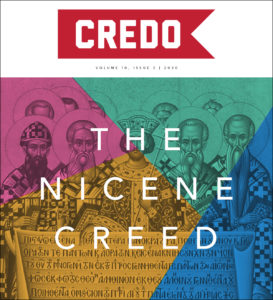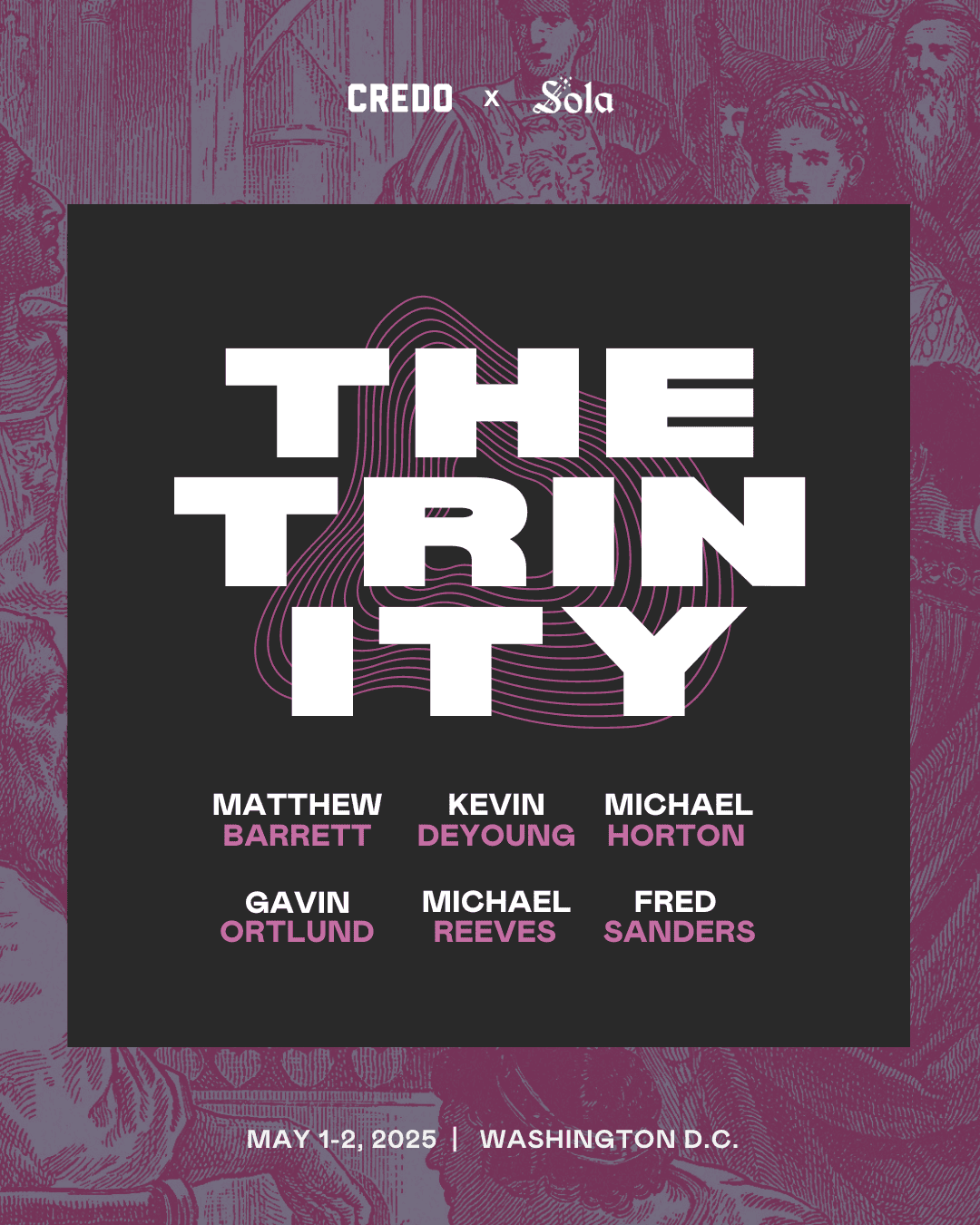“I do not mean the Church as we see her spread out through all time and space and rooted in eternity, terrible as an army with banners.” These are the words C.S. Lewis gave to his character, Screwtape, imagining what a senior demon might think about Christ’s one, holy, catholic, apostolic Church. “That,” adds Screwtape with a disdainful shudder, “I confess, is a spectacle which makes our boldest tempters uneasy.”[1]
This Church – the one spread out through all time and space and rooted in eternity, terrible as an army with banners – is what we confess to believe in when we affirm the Nicene Creed. Not only do we confess to believe in it, we confess also to be a part of it. To be a Christian is necessarily to be a footman in this army; to march behind a sea of faithful warrior-saints who have gone before us, and in front of many who will follow – all on our way to storm the wobbling gates of hell (Matt. 16:18). To be a Christian is necessarily to be a footman in this army; to march behind a sea of faithful warrior-saints who have gone before us, and in front of many who will follow – all on our way to storm the wobbling gates of hell. Share on X
Of course, this description of the Universal Church, romantic though it sounds, is hard to square with the week by week experience of most local churches. What hath Nicaea to do with the struggling First Baptist Church of Middle-of-Nowhere? And more broadly, what does catholicity even mean for Nicene-affirming Protestants? So long as a conflation between “spiritual unity” and “structural unity” remains, a Protestant-Catholic is nothing short of an oxymoron.
Nicene Oneness
It is very tempting to pine after an era of the Early Church marked by ultra-unified structure; the golden days when polity was completely and totally uniform. But, alas, such a picture is likely a historical fiction. It took a while before Rome consolidated formal authority, and until that point, Nicaea functioned as a doctrinal ballast for the Christian Church. It was understood by those who affirmed it as a codification of the “Rule of Faith” – the “faith once for all delivered to the saints” (Jude 3) – which means that the “oneness” and “catholicity” its proponents defended was not the kind of “oneness” and “catholicity” many of our Roman Catholic friends defend today. It was rather a convictional “oneness,” which means it is just as much a part of Protestant (and, dare I say, evangelical) heritage as it is a Roman Catholic or (big “O”) Orthodox heritage. This is why Protestants can confess the “apostolic” line in the creed with no guile. We affirm an “apostolic succession” of a kind, though it may be better to describe it as a “apostolic foundation,” from which we never move beyond (Eph. 2:20-21). “Oneness” in the Nicaean sense, need not imply an absolute structural or relational oneness.
None of this is to imply that structural or relational unity is unimportant. Indeed, the spiritual “oneness” that all true Christians share is ample motivation to pursue as deep a unity as possible; bitter factions are manifestly un-Christian. At least, they ought to be; for we are painfully aware that even if sectarianism is un-Christian as a prescription, it is all-too-Christian as a description. The presence of factions can be spotted all the way back in the New Testament Church (1 Cor. 3:1-9); the tribalism Protestants (sometimes, rightly) get a bad rap for has had to be confronted and rebuked in the Church for two thousand years.
This means that Christ’s prayer for his disciples’ unity (Jn. 17:20-21), while implying a great deal for how Christians ought to act toward one another, nevertheless speaks to a deeper oneness – a spiritually essential oneness that transcends the visible divisions, despite the best efforts of some. Otherwise, Christ’s prayer is in fact ineffectual, and held hostage by our actions (a dreadful thought). No, Christ has torn down the dividing wall of hostility, and sinfully try as we may to re-erect it, we will ultimately be unable (Eph. 2:14-22). Therefore, just as how all Christians are “holy” in an already/not yet sense – positionally holy in Christ, progressively holier in the present age – so too are all Christians “one” in an already/not yet sense. And just like how the Church’s positional holiness ought to motivate her progressive holiness, so too should her positional, eschatological oneness motivate a relational oneness in the present age. Just as how all Christians are “holy” in an already/not yet sense – positionally holy in Christ, progressively holier in the present age – so too are all Christians “one” in an already/not yet sense. Share on X
Rather than trying to undo the unifying work of Christ, all Christians – that is, the “one body” brought about by the “one Spirit” and called to the “one hope,” under the authority of the “one Lord,” who profess the “one faith” expressed in the “one baptism,” to the glory of the “one God and Father” (Eph 4:4-5) – ought to recognize their unity in Christ.
On Not “Ending Protestantism”
Does this then mean an “end of Protestantism?” Not at all.[2] For one thing, we can’t stop protesting because none of Rome’s dogma of yesteryear, which forced the hand of our Reformed forbearers, has yet been amended or corrected. By all accounts, the theological distance between Rome and “her rebellious children” (as Hans Küng put it) has not narrowed, but only grown. Even if this were not the case, “ending Protestantism” would still be a mistake, since it would necessarily assume that “increasing oneness” amounts to “increasing Romishness.” It would assume, in other words, that “oneness” has a scent and sound, which is the smells and bells of Rome. I can’t imagine why Protestants should all of a sudden flip the script and start arguing with Roman Catholics that Rome is the one true Church.
All this to say, the decision to move with the grain of Christ’s cosmic Church unity, and not against it, should not look like Protestants rushing to pick up a rosery. Nor should it look like attempting to find the least common denominator. A thin ecumenism is a weak and brittle ecumenism. Instead of collectively agreeing to climb out of our denominational entrenchments to try to find a ground wide and level enough to fit everyone on, we should stay where we are and begin digging. And no, we shouldn’t dig just deep enough so that the top of our trench puts everyone else out of view – isolation isn’t the goal. We should keep digging, further and further down. If we do, we will ultimately hear the happy clank of our shovels hitting each other as we reach our common core. The ecumenism we should strive after, in other words, is not a thin horizontal ecumenism, but rather a thick vertical one; our “common ground,” the place where we recognize our oneness, is not on earth’s crust, but at its core. And there, like a bush ablaze but not burning, the words of the Nicene Creed invite us to rally around them.
There will, of course, come a day when this “already/not yet” unity will shed its “not yet” description, and the Universal Church’s transcendent oneness will immanentize. In that day, the common ground won’t be limited to the core, but will extend out to the crust of the New Earth. If we keep this in mind, we can avoid the temptation to either minimize or exaggerate our differences. It will not surprise me in the least, for example, to find brothers and sisters in Christ walking around that glorified Earth who were Presbyterians in this age. Though I am convinced that many of them will have been sprinkled in the Triune name, but never formally baptized rightly, I do not doubt that there is nevertheless a Spiritual baptism we share in common (Rom 6:1-4). In fact, shocking though it may sound to some, I suspect the New Earth will be home to more than a few heavenly citizens who were Roman Catholics in this life, who managed to arrive despite their Church’s teaching on justification.
Nicaea in the Middle of Nowhere
This eschatological, “already/not yet” vision helps us to answer the question I raised above: what hath Nicaea to do with the struggling First Baptist Church of Middle-of-Nowhere (let’s call her FBCM)? The answer is that the Universal Church described in the Nicene Creed only becomes visible here and now in local churches, like FBCM. The moment our triune God saves a sinner by grace, the sinner has been enlisted in Christ’s cosmic army (though it is true enough that some prefer to go awol).
There are, in point of fact, no truly “lone wolf” Christians. A Christian is one who is baptized by the Spirit into “one body” (1 Cor. 12:5), delivered “from the domain of darkness” and transferred into “the dominion of [God’s] beloved Son” (Col. 1:13), and a “living stone” who is, together with other Christians, being “built up as a spiritual house, to be a holy priesthood, to offer spiritual sacrifices acceptable to God through Jesus Christ” (1 Pet. 2:4-5).
To be a Christian is to be a member of the One, Holy, Catholic, and Apostolic Church, because God is in the business of binding and loosening in heaven. But how does that which is bound and loosened in heaven become bound and loosened on earth? Who is responsible for declaring and legitimizing the new member’s status in the Universal Church? To whom does Christ hand his keys to the Kingdom, in order to bind and loosen on earth that which is bound and loosened in heaven (Matt 16:18-19, 18:15-20)? Local churches like FBCM.
The Church is the Bride of Christ; a people from every tribe and tongue and nation, who have been elected from the foundation of the world, and purchased by the blood of Jesus. This Universal Church is made visible in local churches, and only in local churches. Her members are certainly present all over the place, but you can’t see her until local churches gather. Without little churches like FBCM, talk of the Universal Church would be vacuous. The concept remains phantasmal and ghostly until incarnated with bodies, bread, wine, water, and Word. Without local churches, talk of the Universal Church would be vacuous. The concept remains phantasmal and ghostly until incarnated with bodies, bread, wine, water, and Word. Share on X
Our unimpressive little assemblies are the image of the invisible Church, and whether local churches realize this or not, they are in the same family tree as the fourth century fathers who produced the Nicene Creed. In our lineage are figures like Athanasius and Nicholas (who, unfortunately, probably never gave Arias a wallop, but if it helps the rumbling, tumbling farmer who serves as a deacon at FBCM to value protestant catholicity a bit more, I say we keep the legend going). Our churches lose something major if we lose this sense of family history.
It is a great irony that the classic fundamentalist creed, “no creed but the Bible,” places the liberal-theology-fearing church in danger of losing biblical fidelity. It is no accident that an antipathy for tradition and a crude biblicism lead so often to aberrations to central doctrines like the Trinity, or divine simplicity. The fruit of Nicene Trinitarianism is the product of a particular kind of tree—a way of reading Scripture with roots deep in a specific metaphysic and tradition. Once those roots are cut, we shouldn’t expect to see the same kind of fruit.
Out of a protestant love for Scripture, our local churches should be (small “c”) catholic. Which is to say, our local churches should stop imagining that they popped up in a vacuum. They should come to recognize who they are; to the degree that they are in fact churches, they are a part of the One, Holy, Catholic and Apostolic Church, and they only stand to benefit from waking up to this fact. It is not inconsequential that “catholic” and “apostolic” are placed next to one another. It is downright silly to expect the latter without the former.
But at the end of the day, there is a sense in which local churches are “catholic” whether they like it or not, and there’s not a thing they can do about it (short of apostasy). Little sectarian churches, riddled with sin, myopic and factionist, are, mysteriously, the visible expressions of the One, Holy, Catholic, and Apostolic Church. It is astounding, and just like God and his subversive ways, to send this “terrible army” on the march armed with nothing more than a book, water, cheap wine, and stale bread. Somehow, though, this is fittingly foolish (1 Cor. 1:18-31) for a community that proclaims how death was killed by Life, when Life was killed by death (1 Cor. 2:8).
Endnotes
[1] C.S. Lewis, The Screwtape Letters, Reprinted Ed. (New York, NY: HarperOne, 2015), letter 2.
[2] For anyone with ears to hear, this is obviously a cheeky jab at Peter Leithart and his book, The End of Protestantism: Pursuing Unity in a Fragmented Church (Grand Rapids, MI: Brazos Press, 2016). I should like to add that as a big admirer of Leithart, I mean no disrespect for my disregard of his strategy for oneness here.


